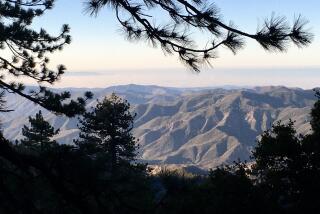Forest Service Cuts Tongass Tree Harvest
- Share via
WASHINGTON — The U.S. Forest Service decided Friday to reduce by half the maximum amount of timber cutting allowed in Alaska’s Tongass National Forest, the largest temperate rain forest on Earth.
Still, the decision will open previously untouched acres of the forest to chain saws at a time when logging there remains perhaps the most controversial in the country.
President Clinton and Vice President Al Gore made their opposition to clear-cutting in the Tongass an important element of their campaign-year environmental program. And despite a continuing decline in the allowable cut, the Forest Service’s announcement prompted sharp complaints from environmentalists and loggers.
The plan that was devised for the vast forest--at 17 million acres it covers more land than all of the national forests in timber-rich Oregon--leaves unclear the ultimate role the administration sees for the Tongass: Are its stands of ancient Sitka spruce and hemlock money-making timber for the declining mills of southeastern Alaska, where they have been a mainstay of the local economy? Or should their harvest be restricted to leave the forest untouched?
“This is the forest the president said he’d save,” said Nathaniel Lawrence, director of the Natural Resources Defense Council’s forestry project.
But echoing a complaint raised by the Alaska Forest Assn., Rep. Don Young (R-Alaska) said in a written statement: “This huge reduction [in logging] means no real benefit for the animals and plants, but it does mean lost potential for Alaskans who work for a living in the wood products industry.”
*
The Forest Service plan calls for cutting as much as 267 million board feet a year, down from the 450 million board feet allowed on average in each of the past 10 years. A board foot, the standard measure of timber, is one square foot of lumber one inch thick.
The number of trees needed to produce 1 million board feet--enough to build about 100 homes--cover about 40 acres of Tongass forest, where the spruce, hemlock and cedar form a cathedral-like canopy dripping with moss.
Under the plan that guides management of the forest for the next 10 years, the Forest Service would put 1.1 million acres that are considered critical to wildlife off limits to loggers.
It would also provide 1,000-foot buffers along beaches and river mouths as wildlife travel corridors and habitat protection.
That plan, said Phil Janik, the chief U.S. forester in Alaska, “marks the start of a new era for the nation’s largest and most pristine rain forest--an era of environmentally sound management of its precious natural resources.”
Critics said, however, the plan continues to rely on logging in new areas, requiring the building of roads that leave scars through the forest and create risk of water runoff that can pollute streams. It also relies on clear-cutting as the dominant practice.
Thus, said Eric Jorgensen, an attorney with the Sierra Club Legal Defense Fund, while the maximum number of trees that can be cut is declining, the overall environmental practices are unsatisfactory, and questions remain about whether the proper acreage is being chosen for logging.
Drawing attention to the sensitivity of the land, its wildlife and plants, and unanswered questions raised about the impact of logging, an independent panel of scientists asked to review logging conditions there told the Forest Service last year: “At least until adequate research has been completed on a representative sample of fauna and flora, further logging in the remaining relatively undisturbed watersheds of the Tongass should be regarded as inconsistent with ensuring the continued viability of resident wildlife populations.”
More to Read
Sign up for Essential California
The most important California stories and recommendations in your inbox every morning.
You may occasionally receive promotional content from the Los Angeles Times.










